Lyn Hancock – Biography
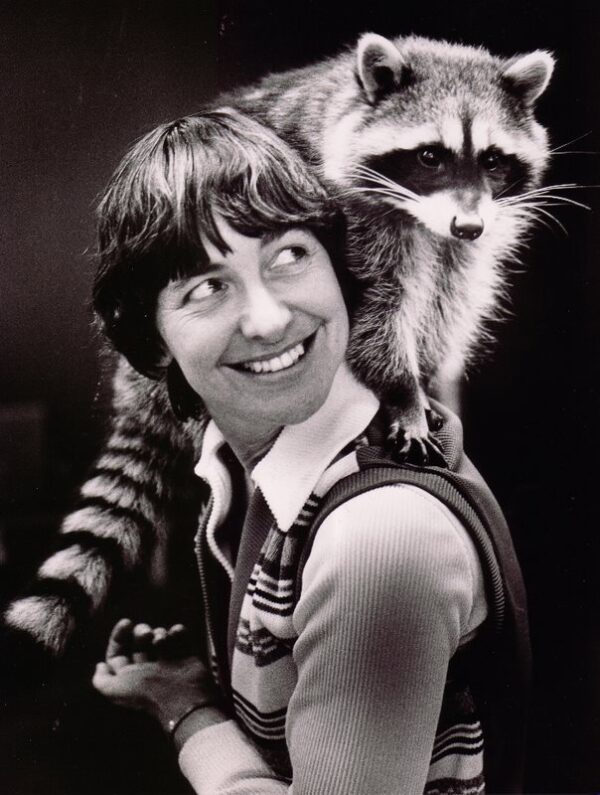 You can find the long version of my life in my twenty books and innumerable articles and pictures because my stories ARE my life. But let me give you the short version.
You can find the long version of my life in my twenty books and innumerable articles and pictures because my stories ARE my life. But let me give you the short version.
I was born in East Fremantle, Western Australia, the most remote city in the world, and that’s probably one of the reasons why I like to explore other remote regions.
As a kid I dreamed of being Christopher Columbus and discovering new worlds. As a Capricornian, I desired to get to the end of the road, to the top of the mountain, to get the most out of every experience, from the South Pole to the North Pole, from the Antarctic to the Arctic.
I don’t know whether or not my adventures come to meet me or I go out to meet them, but I am fascinated by how – through curiosity, chance and coincidence – a day’s events, a person, an animal, a location becomes a story and I feel compelled to tell somebody about what happens.
I thank my grandmother, my Nana, for this obsession for travel, for history, for literature.
From the time I was eight, she gave me a shilling a week to save to see the world. Nana was born in Chichester, England about 1880. When she was about 21, at the turn of the last century, she saw an ad in the Strand in London urging people to migrate to Western Australia.
She persuaded her sister to accompany her then booked a boat for a two-month voyage to the other side of the world, to a frontier that Europeans had only settled sixty years earlier. In those days, that was a pretty gutsy thing to do.
But on the night before the ship sailed, her sister chickened out and Nana went alone. She met her husband in the new colony while working as a waitress near the Fremantle Jail. He, the grandfather I have never met, was a prison warden. Jailer Taylor as he was respectfully called, was in charge of the aboriginal convicts on nearby Rottnest Island and that was where my father spent his childhood, and so did I.
About 60 years after Nana boarded a ship in England bound for Australia, I started out to spend her shillings and boarded a ship bound for England. And just as Nana’s sister chickened out the night before the ship sailed, so did my girlfriend, and I too went alone.
London as a destination wasn’t as dangerous in 1960 as Fremantle was for Nana at the turn of the century. Her journey took two months. Mine took nine months. On an impulsive whim to see history first hand – apartheid riots in South Africa, a blood bath in the Congo, and political unrest in the Suez Canal, I jumped ship in Cape Town against the captain’s wishes and hitchhiked to London instead – alone. I haven’t written that book yet. Someday I’ll return to Africa to see how things have changed – but I won’t be hitchhiking and definitely not alone.
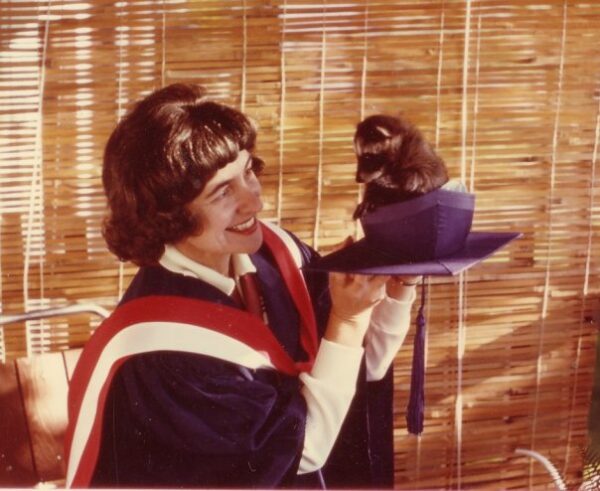 Nana influenced my life in another way as well. I always had an interest in language, especially the spoken language. I was born with a lisp. You know – “Thithter Thuthie thewth thockths for tholdierth.” My English born grandmother paid for me to go to elocution lessons where I learned to recite and act out the English classics – Chaucer, Shakespeare, Dickens – long before I knew what they meant. I remember shocking my mother while memorizing Alexander Pope’s satirical poem Rape of the Lock (cutting off a lover’s lock of hair). When I asked Mum what ‘rape’ meant, she washed out my mouth with soap.
Nana influenced my life in another way as well. I always had an interest in language, especially the spoken language. I was born with a lisp. You know – “Thithter Thuthie thewth thockths for tholdierth.” My English born grandmother paid for me to go to elocution lessons where I learned to recite and act out the English classics – Chaucer, Shakespeare, Dickens – long before I knew what they meant. I remember shocking my mother while memorizing Alexander Pope’s satirical poem Rape of the Lock (cutting off a lover’s lock of hair). When I asked Mum what ‘rape’ meant, she washed out my mouth with soap.
However, despite all those speech lessons, I didn’t really believe that I had a lisp. Not till the age of eighteen when I had private students of my own but couldn’t collect my teaching certificate until I got rid of my speech defect, was I sufficiently motivated to recognize this fact and do something about it.
So from an early age, I studied and taught English (and French), mime and movement, speech and drama. My first job as a teacher was to develop a curriculum in Spoken English at Kent Street High School in Perth, not only to emphasize the importance of good language skills but to practically eradicate the lackadaisical Aussie accent. In those days the aim was to speak like the Queen not Crocodile Dundee.
I also taught Sunday School and studied the Bible. I digested its parallelism and balance, its rhythm and imagery. I memorized thousands of lines of poetry. I always had a camera and took pictures. I kept a diary, I talked a lot, I always had my nose in a book.
When I analyze my writing style today I can see how all these factors led to the way I write. My style is conversational, rhythmic, dramatic, graphic and photographic. I live life as a story (which sometimes gets me into trouble) and I love telling stories of that life to a live audience, accompanied by my pictures. I paint pictures with my words and I tell stories with my pictures.
As early as primary school I entered and won essay competitions but I decided to be a teacher not a writer. In Western Australia we had to choose our career at the age of twelve. I don’t think writer was on the list. However, when I set off to see the world with one of my major destinations the Rome Olympics, I did ask the editor of the West Australian newspaper if I could send him stories from the Games. I sat in the Via Veneto with pen and paper and wrote the story of what happened one dramatic night when I smuggled myself into the Olympic Village. Trouble was, by the time I snail mailed my manuscript home to Australia, the Olympics were over. In those days reporters phoned in their stories.
After hitchhiking through Africa and Europe, studying and teaching in England and Montreal, I reached Vancouver, British Columbia to board a boat home to Western Australia to take up a teaching position at a university.
My plans changed suddenly.
On the eve of my departure with my luggage already on board and my cabin mates met, I got engaged on my first date to a student wildlife biologist while flying around eagle nests on the west coast of Vancouver Island. “You’re the first girl who hasn’t got sick in my floatplane,” said David Hancock. “You Aussie girls are tough. Marry me.”
Click here to read an article Lyn wrote about how she married the “Ideal Man”.
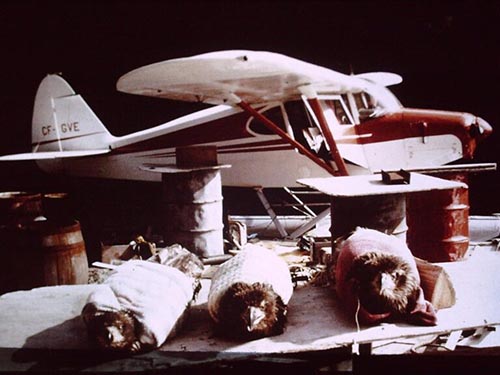
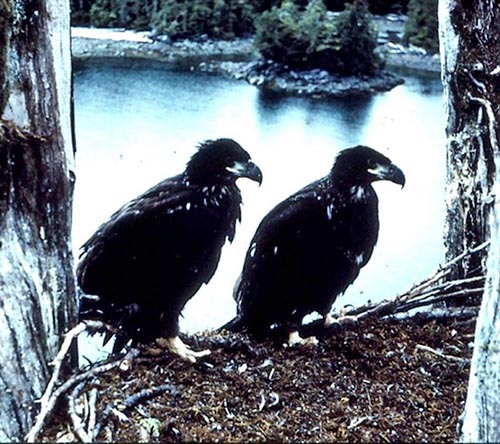
Always a creature of impulse, I sent a telegram back to my family on the other side of the world. “Met the perfect man. Flying home. Please prepare a wedding for next Saturday.” They were stunned but Aussies are adaptable and I was married within a couple of weeks. My first present, delivered to the church during the wedding ceremony as a gift from the local veterinarian, was a live wedge-tailed eagle. My next test as a wife was to get it and another bird back to Canada. How? You’ll find the answer in There’s a Seal in my Sleeping Bag and There’s a Raccoon in my Parka.
Within a month or so of my return to Canada, many more animal orphans were to land on my doorstep and take up residence in my backyard, my kitchen, my bed: eagles, puffins, sea lions, bears, cougars, raccoons, even a gibbon ape. As soon as I got a job teaching in Vancouver and later Victoria, I took them all to school.
You write what you’re fascinated by and I was fascinated by my new life in Canada, not only the wildlife but a wilderness of islands, fiords and rainforests. When reporters interviewed us about our bizarre life and getting it wrong, I started writing my own stories in newspaper columns and magazines.
After David aborted his plan for me to have a baby crossing the Northwest Passage in a rubber boat as a way to draw attention to the fragile ecology of the Arctic, we separated. He went south and I stayed in Canada’s north. For 25 years, I wandered with a camera, notebook, and backpack through northern BC, Yukon, Northwest Territories, and Nunavut. I rarely knew where my next meal was coming from, or where I would end up at night or what I would be doing or who I would be doing it with.
One such story about sitting for nine hours in an eagle nest with two eagles on my lap attracted the attention of Sir William Collins of Glasgow, the famous publisher of the Collins Bible, the Collins Dictionary, and the books of Gerald Durrell and Joy Adamson. Sir William flew to Canada to ask me to write a book. My first book There’s a Seal in my Sleeping Bag became a best seller and is still available today in an updated form. Nineteen books followed, almost all based on personal experience.
But those years winging it through the vast north country at the edge of the world were magic years for me, I will never forget the landscapes, the animals, the people, or the adventures. I felt as near as I could be to Columbus.
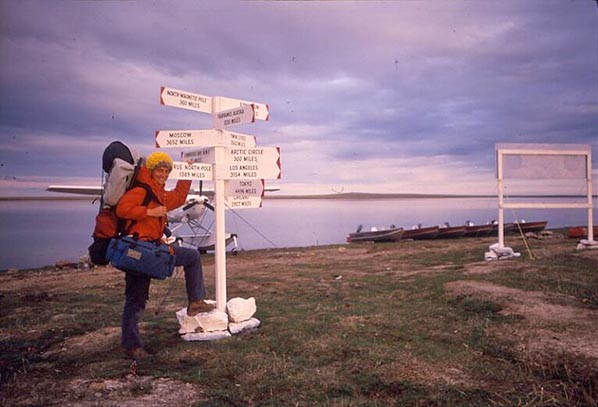 Memories. Driving with my parents on the Dempster Highway, the first tourists to cross the Arctic Circle. Driving with the ice road truckers to the Arctic Ocean long before they were immortalized on television. Asking three pilots to pose for a photo in Taloyoak then accepting their invitation for an aerial tour of my favorite fishing holes. Asking two strangers on the street in Resolute Bay who they were and where they were headed and they invited me to join them, two Poles on their way to the North Pole. Arriving in Resolute again with nothing planned and being invited while still at the airport to play golf in the midnight sun at the northern end of Ellesmere Island. Not your ordinary game of golf. We hit big bouncy orange balls with broom sticks, hockey sticks, and conduit pipes.
Memories. Driving with my parents on the Dempster Highway, the first tourists to cross the Arctic Circle. Driving with the ice road truckers to the Arctic Ocean long before they were immortalized on television. Asking three pilots to pose for a photo in Taloyoak then accepting their invitation for an aerial tour of my favorite fishing holes. Asking two strangers on the street in Resolute Bay who they were and where they were headed and they invited me to join them, two Poles on their way to the North Pole. Arriving in Resolute again with nothing planned and being invited while still at the airport to play golf in the midnight sun at the northern end of Ellesmere Island. Not your ordinary game of golf. We hit big bouncy orange balls with broom sticks, hockey sticks, and conduit pipes.
More memories. Swimming impossible rivers. Sleeping in melting igloos. Watching in frozen horror while a black bear attacked four people.
Running panic-stricken from a grizzly. Creeping up on a polar bear, its back against a boulder, its paw holding a flower. Camping with master carvers wresting the sea goddess Sedna from a marble beach. Hiking the tundra with Susie, the last tattooed woman in the north, hunting caribou with her dogs and hearing her say in Inuktitut, “We’ll miss you when you’re gone, Lyn Tiktalik.”
Winging it in the North tells some of these tales. There are so many more. You can read more about these adventures right here.
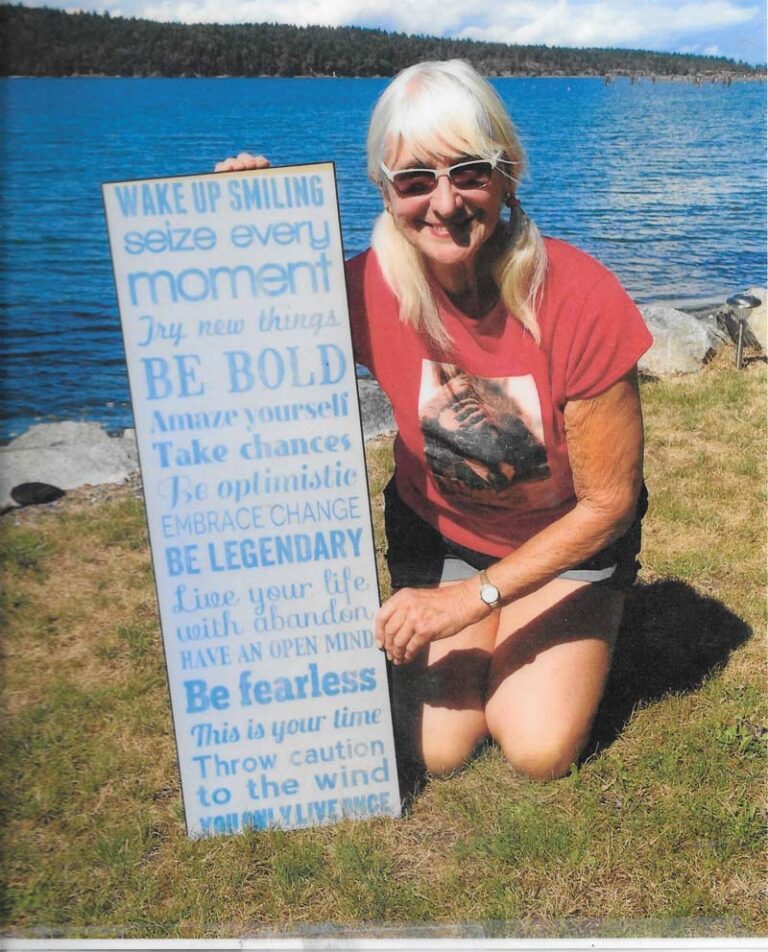
I was lured south by the pleas of a second husband who proposed to me, not several hundred feet above ground while flying around eagle nests over Vancouver Island on the west side of Canada, but this time several feet underground while celebrating Christmas under caribou skins in a semi-subterranean sod hut on Baffin Island on the east side of Canada. Parallelism again. Life writing itself.
So now I’m back in BC on a secluded beach in Nanoose Bay, exploring my world by kayak. Wild creatures still come to my door. A pair of eagles mate at the top of the tree at the edge of the lawn and I hear their chitters from my bed. Three times otters have left a still-flipping flounder on the red welcome mat at my front door. Black oystercatchers wheel and whistle along the shoreline. Wintering scaups and scoters, goldeneyes and mergansers chase and dive and splash above the tide-covered clam and oyster beds. Sea lions huddle together on rocky beds above a gravel beach, belching as you paddle by. Seals have their pups on nearby islands. Raccoons scuffle at night outside the patio glass doors but only once have I seen a raccoon during the day. That was the one who provided the dramatic climax to Tabasco the Saucy Raccoon.
Animals still play an important role in my life and my books. And though my latest book is a history book The Ring: Memories of a Metis Grandmother, written in collaboration with the mother of two of my former students, it too began with an animal, an orphaned gibbon ape in my grade six classroom in Victoria.
My passion for winging it while living on the edge continues when I leave my Nanoose base to travel – to stalk jaguars in the jungles of Belize, to tramp through the gorges of the Bungle Bungles in an Australian desert, to backpack through China, to kayak above the Arctic Circle of Norway, to wherever adventure calls.
Life is always a story.